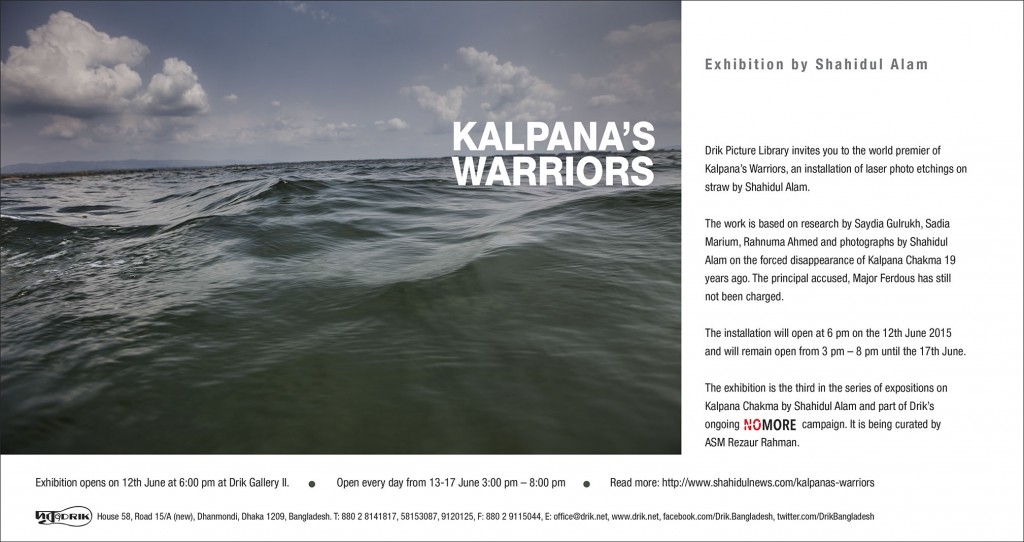Shahidul Alam is a Bangladeshi photojournalist, teacher, and social activist. A TIME “Person of the Year”, he is celebrated for his commitment to using his craft to preserve democracy in his country at all costs. See the project at http://mediastorm.com/clients/2019-icp-infinity-awards-shahidul-alam
Category: security
An Exodus of Pain
সেনাবাহিনী বিষয়ে আমার বক্তব্য খন্ডিতভাবে প্রচার করে বিভ্রান্তির সুযোগ তৈরি করা হচ্ছে
সম্প্রতি বাংলাদেশ আওয়ামী লীগ তথ্য প্রযুক্তি বিষয়ক নির্বাচন পরিচালনা কমিটি নামক একটি ফেইসবুক পেইজ থেকে ২০১৩ সালে ডয়েচে ওয়েলেকে দেয়া আমার একটি সাক্ষাৎকার থেকে খন্ডিতভাবে এক টুকরো অংশ উদ্ধৄত করে একটি ভিডিও কন্টেন্ট তৈরি করে সেখানে বলেছে:
“দেশপ্রেমিক সেনাবাহিনী ও জনগণকে মুখোমুখি করতে গভীর ষড়যন্ত্রে লিপ্ত ছিল শহিদুল আলম। সেনাবাহিনীকে বিতর্কিত করতে আন্তর্জাতিক একটি মিডিয়াকে বেছে নিয়েছিলেন তিনি।”
২১ বছর আগে অপহৃত হিল উইমেন্স ফেডারেশেনের নেত্রী কল্পনা চাকমাকে নিয়ে আমি ২০১৩ সালে যেই প্রদশর্নী করেছিলাম তার উপর দেয়া ওই সাক্ষাৎকারের প্রায় পুরোটুকু ফেলে দিয়ে মাঝখান থেকে খন্ডিতভাবে ছোট এক টুকরো অংশ কেটে নিয়ে তারা যেভাবে প্রচার করছে তার থেকে বিভ্রান্তির সুযোগ তৈরি হচ্ছে। উল্লেখ্য, কল্পনা চাকমার অপহরণের সাথে সেনা সদস্যর সংশ্লিষ্টতার যে অভিযোগ, যার উল্লেখ আওয়ামী লীগের শীর্ষ স্থানীয় নেতা ও সাবেক স্বরাষ্ট্রমন্ত্রী মহিউদ্দিন খান আলমগীরও ২০০৯ সালের একটি টিভি টক শোতে করেছিলেন, সেই অভিযোগের কোন বিচার এত বছর ধরে হয়নি। পাশাপাশি পার্বত্য অঞ্চলে যে জাতিগত নিপীড়ন চলমান তারও কোন সুরাহা দশকের পর দশক ধরে হয়নি। এরই প্রেক্ষাপটে বিষয়গুলো নিয়ে বিভিন্ন রাজনৈতিক দল, সরকার ও সামরিক বাহিনীর ভূমিকা নিয়ে সামগ্রিকতার আলোকে কিছু আলোচনা আমি ঐ সাক্ষাতকারে করি। পাশাপাশি আমার যে প্রদর্শনী কল্পনা চাকমার অপহরণ নিয়ে হয়েছিল সেই প্রদর্শনীরও নানা দিক আমি সেখানে তুলে ধরি। ফলে সেখানে আমাকে কল্পনা চাকমার অপহরণের উপর বিভিন্ন ধরনের প্রশ্ন করার পর এক পর্যায়ে যখন প্রশ্ন করা হয় “তার মানে এটা কি বলা যায় যে কোন সরকারই আসলে সামরিক বাহিনীর বিষয়ে বিশেষ কোন কিছু, কোন উদ্যোগ গ্রহণে আগ্রহী নয়?” তখন এর উত্তরে আমি যা বলি তা ছিল নিম্নরূপ:
“আমাদের সামরিক বাহিনীর প্রয়োজন আছে কিনা সেটাই আমি প্রথমে প্রশ্ন করি। তেতাল্লিশ বছর ধরে আমরা যে সামরিক বাহিনীকে লালন করছি তারা কিন্তু একবারও দেশ রক্ষার কাজে কোনভাবে নিয়োজিত হয়নি। সেটা ভালো। আমাদের শান্তি আছে সেটা ভাল। তবে বিশাল অঙ্ক কিন্তু এদের উপর ব্যয় করা হচ্ছে যেটা শিক্ষায় যেতে পারত, স্বাস্থ্যে যেতে পারত, অন্যান্য ধরনের উন্নয়নে যেতে পারত, সেটা হয়নি। এমনকি যে জায়গায় তাদের থেকে আমরা কিছু আশা করতে পারি আমাদের এই বর্ডারে যে বাঙালীদের পাখির মতো গুলি করা হচ্ছে, বিএসএফরা গুলি করছে সেখানে প্রতিবাদ করা, সেখানে তাদের অন্তত এই পরিস্থিতিতে বাঙালীদের, বাংলাদেশীদের বাঁচানো সেই কাজেও তারা কোন কিছু করেনি। তাদের একমাত্র কাজ শোষণ করা। এই শোষণ তো পাকিস্তানীরা আমাদের করেছে। আমাদের নিজেদের মিলিটারী আমাদের শোষণ করবে এটা আমরা হজম করব এটা হবে কেন? কিন্তু যে কথা আপনি বললেন, যখন যে সরকারই এসেছে এদেরকে তুষ্ট করাই ছিল তাদের প্রধান কাজ। এবং এটাও ভাবতে হবে যে আমাদের দেশের জাতির পিতাকে যারা হত্যা করেছে, জেনারেল জিয়াকে যারা হত্যা করেছে, আমাদের নেতাদের জেলে যারা হত্যা করেছে তারা কিন্তু এই দলেরই মানুষ।”
কিন্তু আমার উত্তর থেকে বিএসএফ এর সীমান্ত হত্যা ঠেকাতে না পারা এবং জাতির পিতা বঙ্গবন্ধু ও জাতীয় নেতাদের হত্যা বিষয়ক খুবই গুরুত্বপূর্ণ দুটি অংশ সম্পূর্ণরূপে বাদ দিয়ে তারা যেভাবে খন্ডিত আকারে আমার বক্তব্যটি প্রচার করছে তা নিম্নরূপ:
“আমাদের সামরিক বাহিনীর প্রয়োজন আছে কিনা সেটাই আমি প্রথমে প্রশ্ন করি। তেতাল্লিশ বছর ধরে আমরা যে সামরিক বাহিনীকে লালন করছি তারা কিন্তু একবারও দেশ রক্ষার কাজে কোনভাবে নিয়োজিত হয়নি। সেটা ভালো। আমাদের শান্তি আছে সেটা ভালো। তবে বিশাল অঙ্ক কিন্তু এদের উপর ব্যয় করা হচ্ছে যেটা শিক্ষায় যেতে পারত, স্বাস্থ্যে যেতে পারত, অন্যান্য ধরনের উন্নয়নে যেতে পারত, সেটা হয়নি। তাদের একমাত্র কাজ শোষণ করা। এই শোষণ তো পাকিস্তানিরা আমাদের করেছে। আমাদের নিজেদের মিলিটারি আমাদের শোষণ করবে এটা আমরা হজম করব এটা হবে কেন?”
এভাবে আমার প্রায় পুরো সাক্ষাতকারটাই বাদ দিয়ে মাঝখান থেকে একটি প্রশ্নকে বেছে নিয়ে তার উত্তরে আমি যা বলেছিলাম তারও গুরুত্বপূর্ণ দুইটি অংশ বাদ দিয়ে যেভাবে খন্ডিতভাবে আমার বক্তব্যকে উপস্থাপন করা হয়েছে তাতে বিভ্রান্তি তৈরি হতে পারে। আমার কাছে এটা বিস্ময়কর যে আওয়ামী লীগের একটি ফেসবুক পেইজ কি করে আমার উত্তর থেকে জাতির পিতা হত্যাকান্ডের মতো এতো গুরুত্বপূর্ণ একটা অংশকে ছেঁটে ফেলল! আমি মনে করি সামগ্রিকতার আলোকে সামরিক বাহিনীসহ রাষ্ট্রের যেকোন প্রতিষ্ঠান নিয়েই গঠনমূলক সমালোচনা করা প্রতিটি নাগরিকের দায়িত্ব এবং জাতীয় স্বার্থেই সামরিক বাহিনী সহ প্রতিটি রাষ্ট্রীয় প্রতিষ্ঠানের উচিত এসব গঠনমূলক সমালোচনাকে নির্মোহভাবে বিচার-বিশ্লেষণ করা, আমলে নেয়া। সেই রাস্তা বন্ধ করাই বরং সামরিক বাহিনীসহ রাষ্ট্রীয় প্রতিষ্ঠানগুলোকে জনগণের মুখোমুখি করার ষড়যন্ত্রের সামিল।
আমার সাক্ষাতকারের অডিও লিংক পাবেন এখানে। আগ্রহীরা শুনে মিলিয়ে দেখতে পারেন।
শহিদুল আলম
The Guardians: Time Magazine Person of the Year 2018
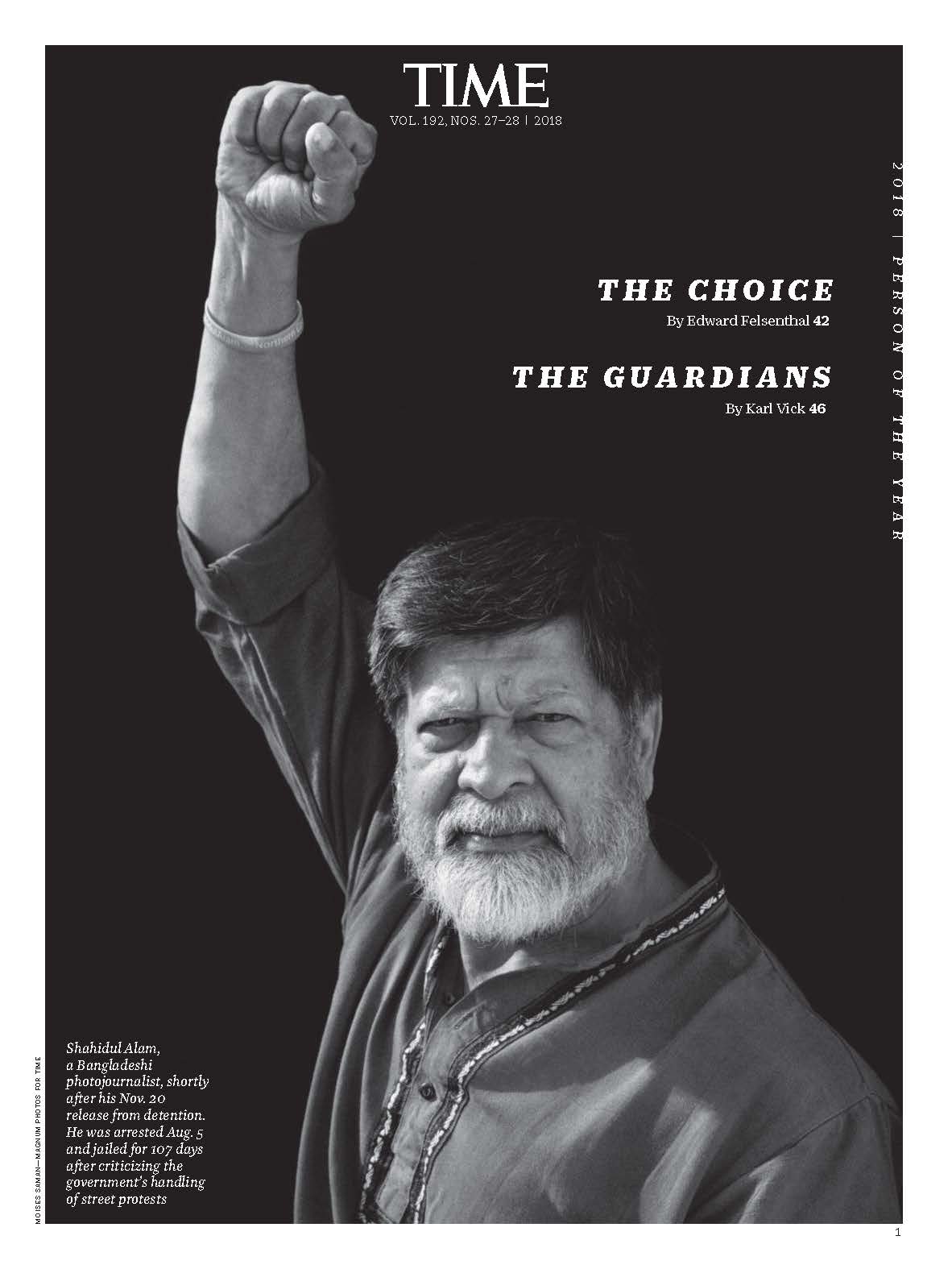
This year brought no shortage of other examples. Bangladeshi photographer Shahidul Alam was jailed for more than 100 days for making “false” and “provocative” statements after criticizing Prime Minister Sheikh Hasina in an interview about mass protests in Dhaka Continue reading “The Guardians: Time Magazine Person of the Year 2018”
Irfanul Islam, and an 8-mile stretch of road
by rahnuma ahmed
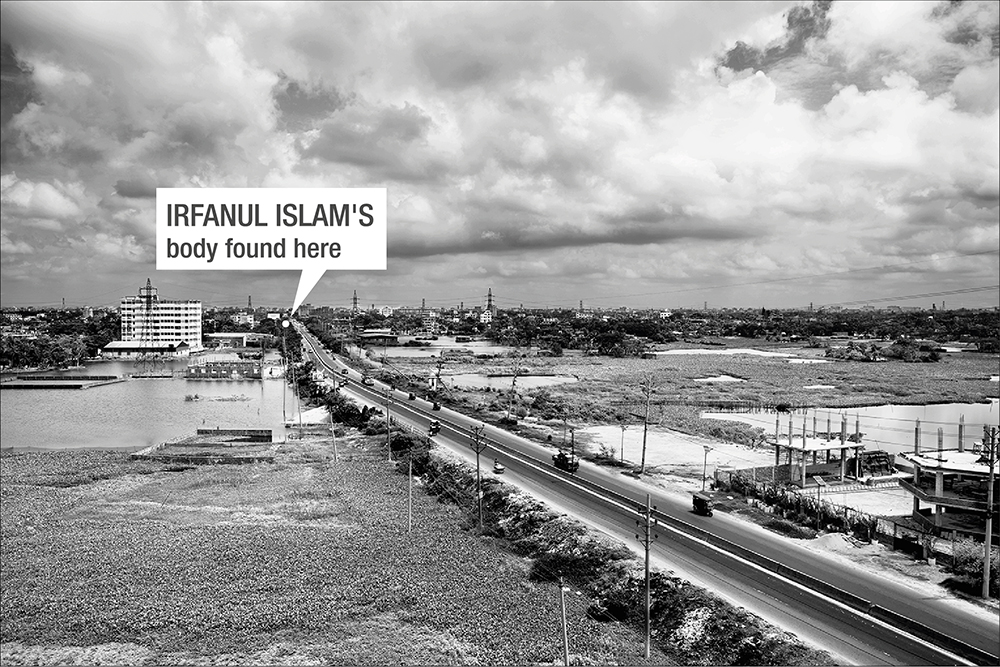
Why was Irfan killed? Why did they have to kill him, if it was for the money, they had already snatched it away, why kill him? Was it accidental, did he die because a novice, or a brute, hit him on the head too hard? Or did he die because he had resisted, because one of his abductors had grabbed his throat and in the ensuing tussle, squeezed it for a fraction of a second too long?
These questions haunt us, as his killers remain untraced, unknown, even now, a year later. Continue reading “Irfanul Islam, and an 8-mile stretch of road”
What Joy Bangla means today
Originally published in New Age
By Shahidul Alam
Joy Bangla in those days had not been commandeered by any political party. It was a slogan we all used. Some took it more to heart than others. I was on a rickshaw heading towards mejo chachi’s house, (she is mother of my footballer cousin Kazi Salahuddin, better known by his nickname Turjo). Seeing a friend on the road I shouted out Joy Bangla. Joy Bangla, he waved back. At mejo chachi’s the rickshawala refused to take my fare. “Joy Bangla bolsen na. apnar thon bhara loi kemne” (You said Joy Bangla. How can I take fare from you?). Despite my insistence he wouldn’t budge. The rallying cry belonged to us all. He saw me as a fellow warrior.
On the 16th December, I had gone into a burning military convoy opposite Sakura hotel and took a partially charred Browning light machine gun as a trophy. Almost at the same site where I had seen, nine months ago, people being gunned down as they ran from the flames on the night of the 25th March. They lived in the slums near the Holiday office. Their brutal death part of a statistical count we still argue about.
Years later, I tried to put together a visual chronicle of the war. Collecting photographs from great photographers from far away lands and many local ones who had witnessed our pain, and shared our victory. There were moments of great bravery and greater sacrifice. There were moments of immense pain. The weight of great loss. Rashid Talukder’s image of the dismembered head in Rayerbazar was one of the most striking. Kishor Parekh?s sculpted frames showing, dignity, honour, elation and loss. Raghu Rai?s monumental images of seas of people seeking shelter. Captain Beg’s rare photographs of the mukti bahini during battle. Mohammad Shafi?s striking image of women smuggling grenades in half-submerged baskets. Aftab Ahmed’s image of the final surrender, stoic and significant.
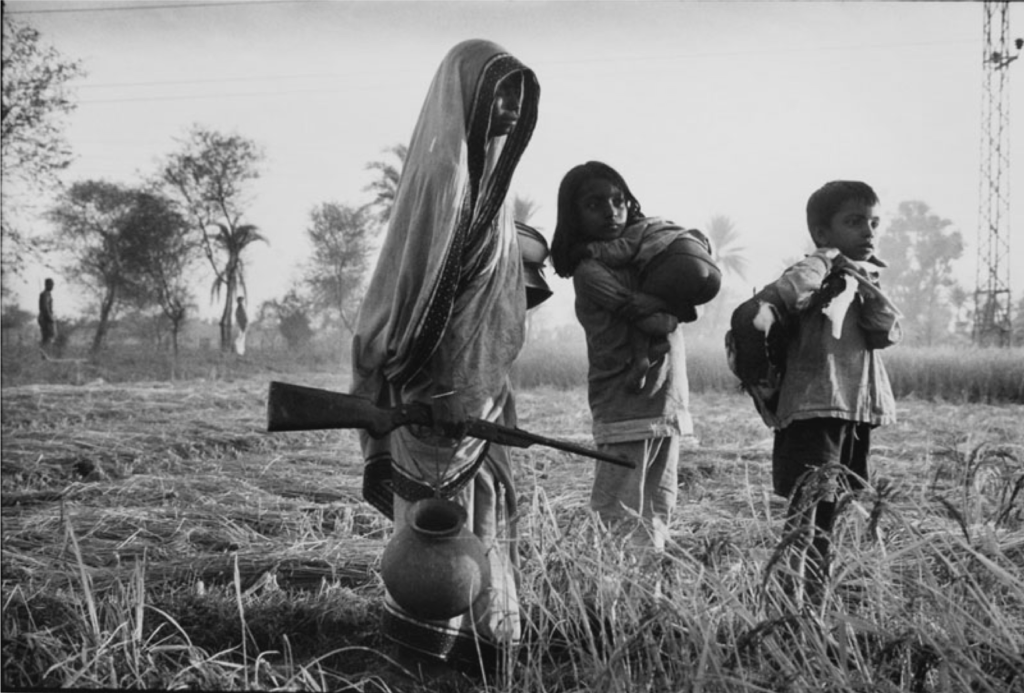
The image that stood out from all the others however, was by Penny Tweedie. Freelancing and without an assignment, Penny had neither the luxury of a client?s budget, nor the assurance of a publishing slot. She did the best she could, getting lifts from fellow photographers, flitting between areas of conflict and stress, she stayed close to ordinary people. People like my rickshawala friend, or the people I saw dying on the night of the 25th March. People who resisted, people who fled, people who sheltered others. People who fed people when they had little food themselves. The image of a woman, carrying a gun walking through a paddy field, with children in tow, was for me the image that encapsulated the war. These were ordinary people who had war thrust upon them. They made do, as best as they could. Bearing their pain with dignity. Fighting with no hope for return. Unlike me, they were not trophy hunters. I doubt if that woman ever made it to a muktijoddha list. I have no way of knowing if she, or her children made it through the war alive. They gave us this nation where we had all hoped we would be free. Continue reading “What Joy Bangla means today”
7/7 Survivor: Why we should not bomb Syria
The major reason for not bombing Syria is the diminishing of our humanity and civilisation.
![7/7 Survivor: Why we should not bomb Syria Anti-war protesters demonstrate against proposals to bomb Syria outside the Houses of Parliament in London [REUTERS]](http://www.aljazeera.com/mritems/imagecache/mbdxxlarge/mritems/Images/2015/12/2/1994c16d0b4b4345a42451413d007f48_18.jpg)

ABOUT THE AUTHOR
John Tulloch
John Tulloch is a British university lecturer who is best known as a survivor of the July 7, 2005 London Bombings. Continue reading “7/7 Survivor: Why we should not bomb Syria”
5-year-old Palestinian schools Israeli soldiers on War Crimes
1-minute video: 5-year-old Palestinian schools Israeli soldiers on War Crimes
5-year-old Janna Ayyad shames Israeli soldiers with Sami Yusuf?s poetry:
All your armies, all your fighters,
All your tanks, and all your soldiers,
Against a boy holding a stone.
Standing there all alone,
In his eyes I see the sun.
In his smile I see the moon.
And I wonder, I only wonder.
Who is weak, and who is strong?
Who is right, and who is wrong?
And I wish, I only wish,
That the truth has a tongue!
Between absence and presence
Between absence and presence

AWARD-WINNING film-maker Tareque Masud, broadcast journalist Mishuk Munier and three others died in a car crash on August 13, 2011 when a Chuadanga-bound bus rammed into the film crew?s microbus on the Dhaka-Aricha highway in Manikganj. It was raining; the bus was travelling at a high speed. Their deaths were instantaneous.
Dhali Al Mamoon, his artist wife Dilara Begum Jolly, Tareque?s wife American-born film editor Catherine Masud, production assistant Saidul Islam, and writer Monis Rafik survived the accident. Mamoon?s injuries were the most severe. Continue reading “Between absence and presence”
Kalpana's Warriors
Remarkable: Noam Chomsky
Absolutely stunning: Jess Worth. New Internationalist Magazine (Oxford)
They told me you were quiet. But I felt the rage in your silence. That when you spoke, they rose above themselves. But I felt their fear. That they held you amidst them. But I felt their loneliness. They pointed to the Koroi tree where you would all meet. The banyan tree under which you spoke. Ever so powerfully. They pointed to the mud floor, where you slept. I touched the mat that you had rested upon, and I knew I had found the vessel that must hold your image.
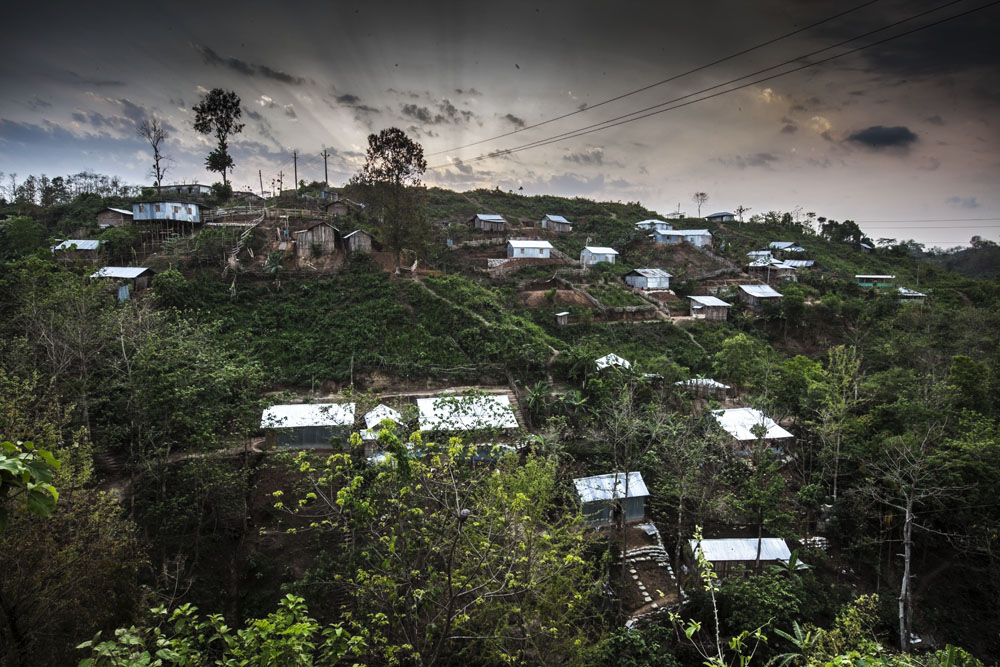
They had tried to erase you, your people, your memory. They had torched your homes and when coercion failed, when you remained defiant, they took you away, in the dead of night.
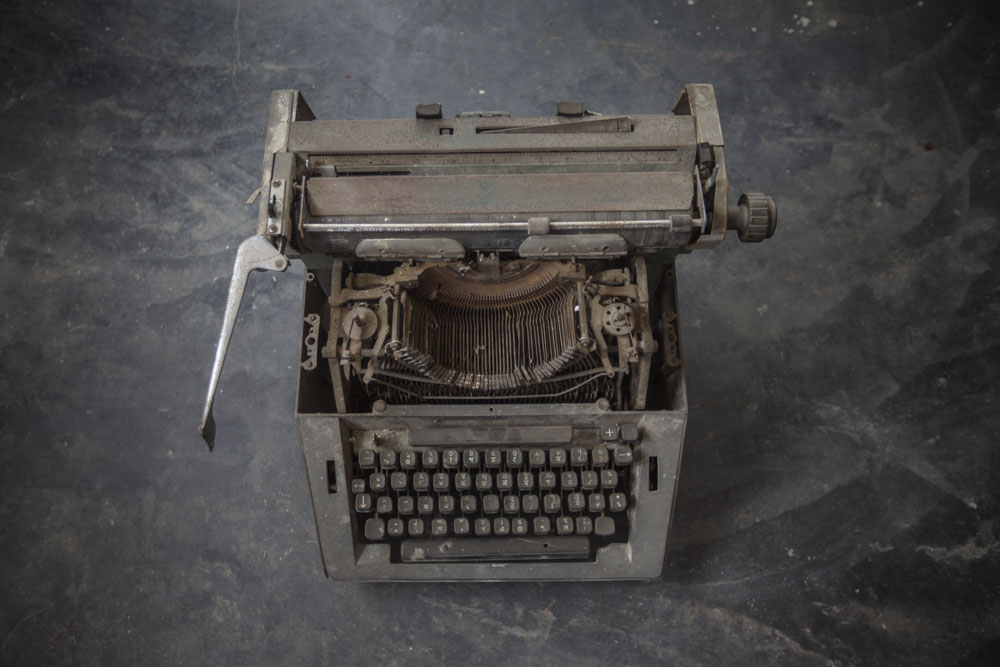
The leaves burned as the soldiers stood and watched. The same leaves they weave to make your mat. The same leaves I shall burn, to etch your image. Will the burning mat hold your pain? Will the charred leaves hold your anger? Will the image rising from the crisp ashen leaves reignite us? Will you return Kalpana?
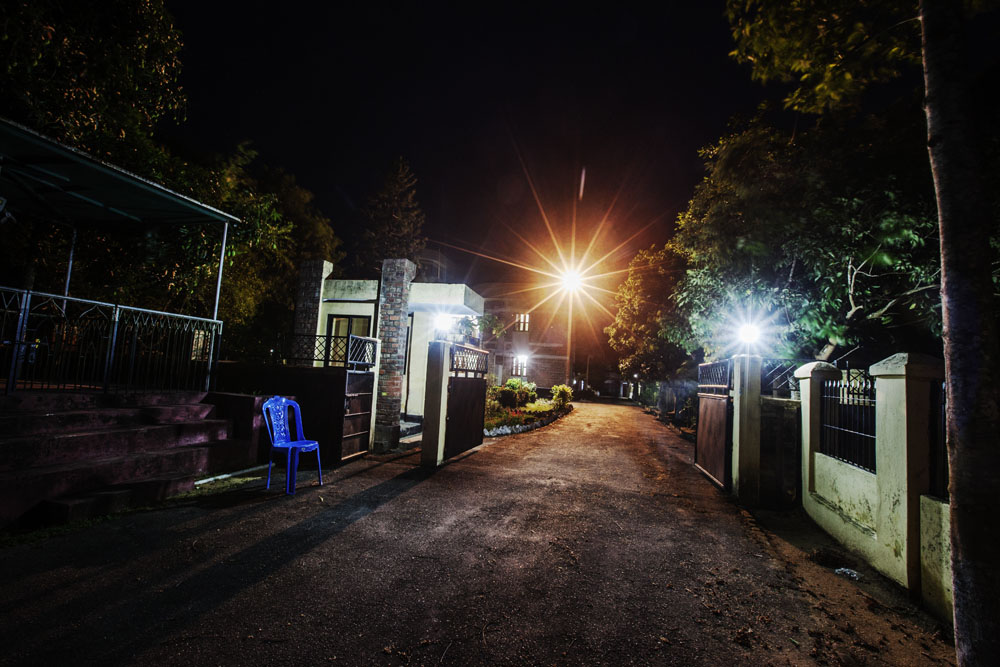
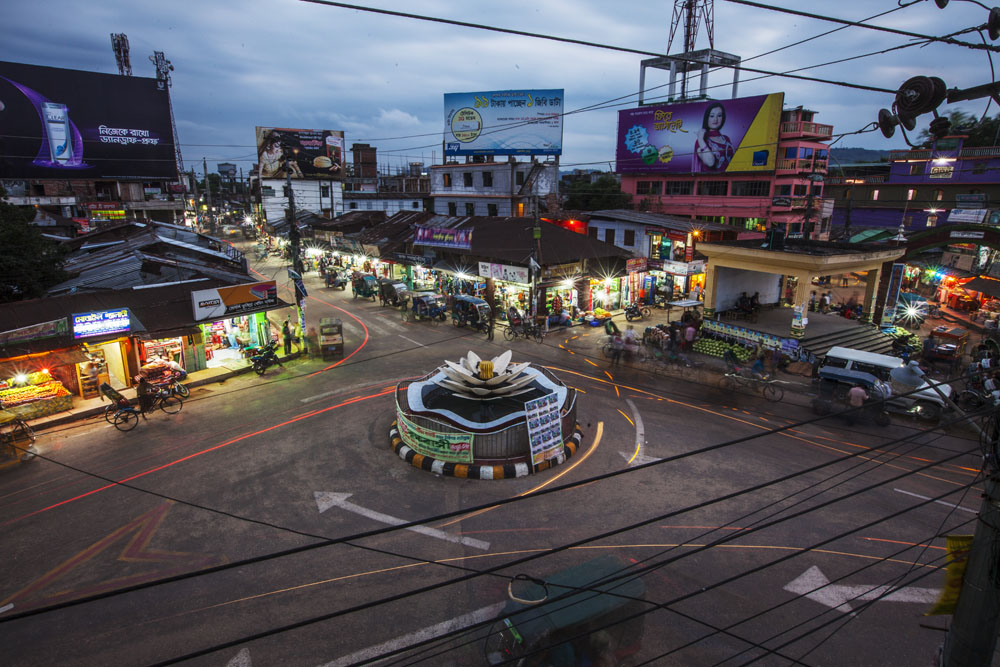
For nineteen years I have waited, my unseen sister. For nineteen years they have waited, your warriors. Pahari, Bangali, men, women, young old. Was it what you said? What you stood for? Was it because you could see beyond the land, and language, the shape of one?s eyes and see what it meant to be a citizen of a free nation? For pahari, bangali, bihari, man, woman, hijra, rich, poor, destitute, Hindu, Muslim, Christian, Buddhist, Atheist, Agnostic, Animist.
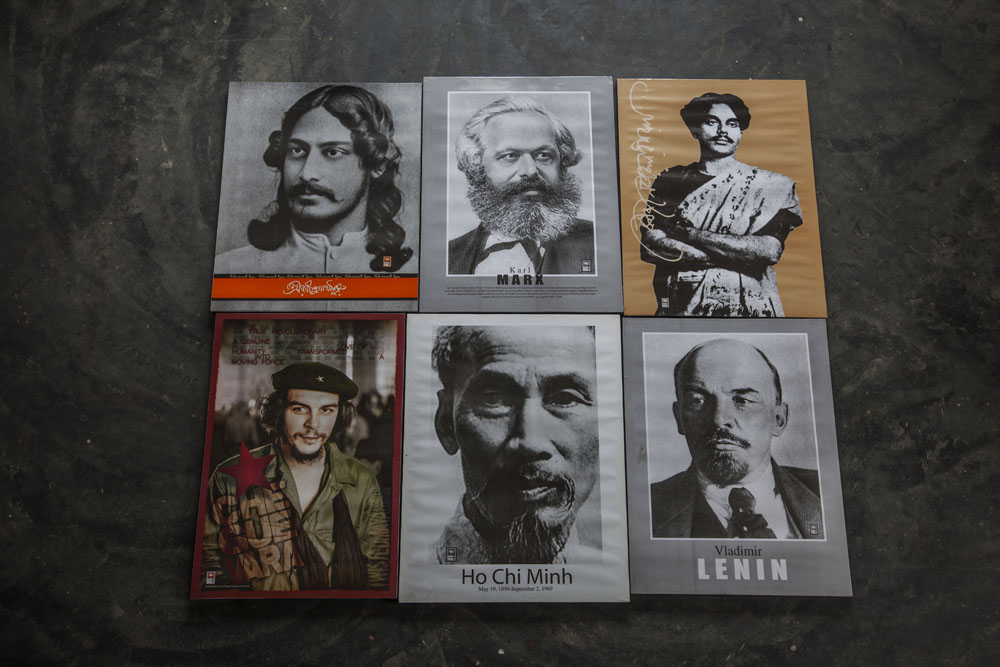
You had reminded us that a nation that fought oppression, could not rule by oppressing. That a people that fought for a language, could not triumph by suppressing another?s. That the martyrs who died, so we might be free, did not shed their blood, so we could become tyrants. That we who overcame the bullets and bayonets of soldiers, must never again be ruled through the barrel of a gun.
That Kalpana is what binds us. That is why Kalpana, you are not a pahari, or a woman or a chakma or a buddhist, but each one of us. For there can be no freedom that is built on the pain of the other. No friendship that relies on fear. No peace at the muzzle of a gun.
These Kalpana are your warriors. They have engaged in different ways, at different levels, sometimes with different beliefs. Some have stayed with you from the beginning. Others have drifted. They have not always shared political beliefs. But for you Kalpana, my unseen sister, they fight as one.
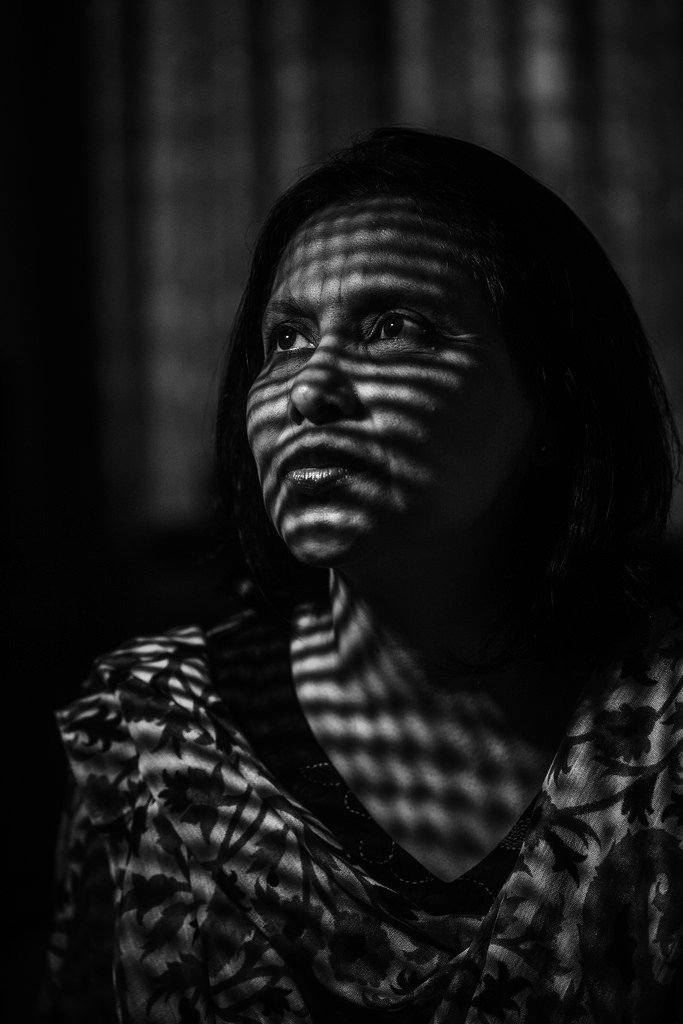
The Process
The process involved in creating these images are rooted to the everyday realities of the hill people, the paharis. Repeatedly, the interviewees talked of the bareness of Kalpana?s home. That there was no furniture, that Kalpana slept on the floor on a straw mat.
Sadia Marium making prints for my upcoming show on Kalpana Chakma #justiceforkalpana #eavig #CHT #military #bangladesh #rights #photography
A photo posted by Shahidul Alam (@shahidul001) on
Rather than print on conventional photographic media, we decided we would use material that was part of pahari daily lives. The straw mat became our canvas. The fire that had been used to raze pahari homes, also needed to be represented, so a laser beam was used to burn the straw, etching with flames, the images of rebellion.
It was the politics of this interaction that determined the physicality of the process. The laser beam consisted of a binary pulse. A binary present on our politics. In order to render the image, the image had to be converted in various ways. From RGB to Greyscale to Bitmap, from 16 bit to 8 bit to 1 bit. To keep detail in the skin tone despite the high contrast, the red channel needed to be enhanced. The Resolution and intensity and duration of the laser beam needed to be brought down to levels that resulted in the straw being selectively charred but not burnt to cinders.
A screen ruling that separated charred pixels while maintaining gradation had to be carefully selected. And then, working backwards, a lighting mechanism needed to be found that broke up the image into a discrete grid of light and dark tones, providing the contrast, the segmentation and the gradation, necessary to simulate the entire range of tones one expects in a fine print. This combination of lighting, digital rendering, printing technique and choice of medium, has led to the unique one off prints you see in this exhibition. A tribute to a unique woman that had walked among us.


